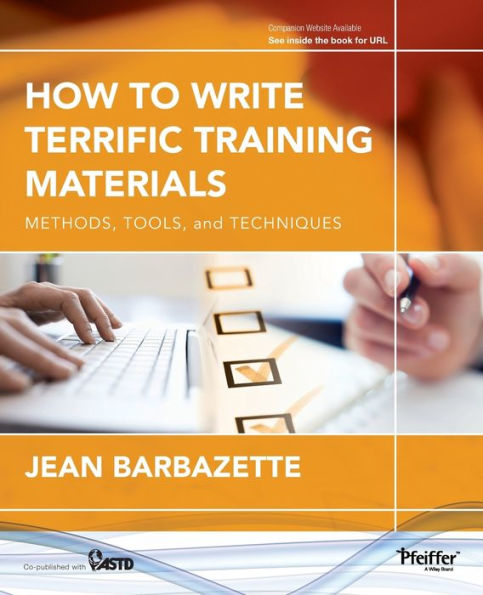Table of Contents
Exhibits and Tools xv
Website Contents xix
Acknowledgments xxiii
Introduction xxv
Chapter 1 Overview of the Design Process 1
Essential Steps in the Training Design Process 2
Where Materials Development Fits into the Design Process 3
A Ten-Part Training Plan to Use as a Blueprint for Materials Development 4
How to Present a Training Plan to Management and Gain Approval 7
Next Steps 7
Chapter 2 Objectives for Writing Projects 9
Instructional Objectives Versus Objectives for Training Program Materials 10
Write Instructional Objectives 10
Four Characteristics of Instructional Objectives 10
Four Elements of Well-Written Objectives for Training Program Materials 14
Sample Objectives for Writing Materials 16
Next Steps 18
Chapter 3 Use the Writing Process 19
Assess Your Writing Skills 20
Use Four Steps to Organize Your Ideas 21
Next Steps 28
Chapter 4 What Are the Best Training Methods? 29
Select the Best Learning Experiences 31
Select the Appropriate Technical Training Methods to Promote Recall and Application 36
Select the Best Audiovisual Support for Materials Design and Delivery 40
Pace Training Methods to Avoid Boredom 42
Determine How Much Practice Is Needed to Learn a Skill 45
Sequence Training Methods Using a Situational Training Model 48
Describe How the Materials Development Process Changes Based on Classroom Versus e-Learning Delivery 51
Next Steps 52
Chapter 5 Develop Materials for Learning Activities 57
Write Three Types of Materials, Depending on the Purpose 59
Use a Seven-Step Process to Design Learning Activities 60
Adapt, Modify, or Create New Learning Experiences 65
Create Discovery Learning by Developing Five Adult Learning Steps to Process Any Learning Activity 68
Distinguish the Use of Different Types of Handout Materials 72
Edit Materials to Address Content and Format Issues 73
Develop Effective and Lean Job Aids 75
Use Different Graphic Looks to Enhance Training Materials 80
Next Steps 87
Chapter 6 Develop Learning Activities to Acquire Knowledge and Skill and to Influence Attitudes 89
Application Sharing 91
The Case Study Method 94
How to Develop a Case Study 106
Discussion or Chat 121
Games and Simulations 124
In-Basket Exercises 132
Interviews 134
Jigsaw Learning, Teaching Learning Teams, Teaching Projects 135
Polling 138
Task Force Projects 138
Writing Tasks 143
Session Starters and Energizers 145
Next Steps 147
Chapter 7 Develop Learning Activities to Acquire Knowledge 149
Lecture 151
Learning Tournaments 155
Self-Study Materials, Printed Resources, and Information Search 157
Course Pre-Work 158
Study Groups 160
Observation, Field Trips, and Video 160
Demonstrations 162
Tests 163
Next Steps 163
Chapter 8 Develop Learning Activities to Acquire Skill 165
Practice and Return Demonstrations 170
Role Play/Skill Practice 173
Next Steps 174
Chapter 9 Develop Learning Activities to In fluence Attitudes 177
Empathy Role Play 179
Inquiry-Oriented Discussions 183
Self-Assessments and Inventories 186
Behavior Modeling 191
Next Steps 194
Chapter 10 Develop Assessments and Tests 195
Why Write Tests? 197
Do We Need to Test? Criteria for Testing 197
Skill Performance Tests 198
Knowledge Tests 199
Test Development Steps 199
Test Reliability 206
Test Validity 207
Skill Performance Rating Systems 209
Next Steps 220
Chapter 11 Develop a Lesson Plan or Leader’s Guide 221
Contents of Lesson Plans 222
Types of Lesson Plans 222
Chapter 12 Design Effective Visual Support 233
Flip Charts, Whiteboards 237
Design Slides with Power 239
Color Psychology 239
Transition and Build Checklist 240
Video Scripting 241
Converting Classrom Training for e-Learning 246
Bibliography 251
About the Author 253
Index 255






